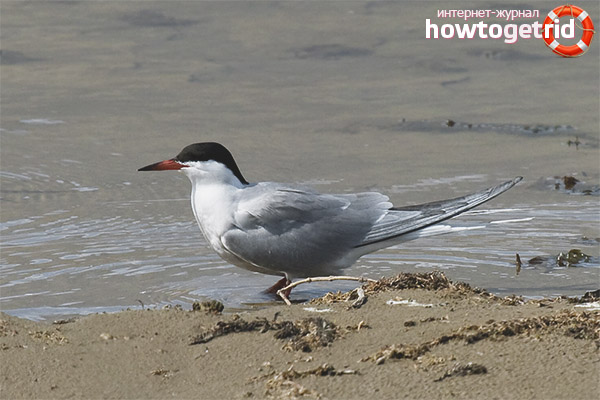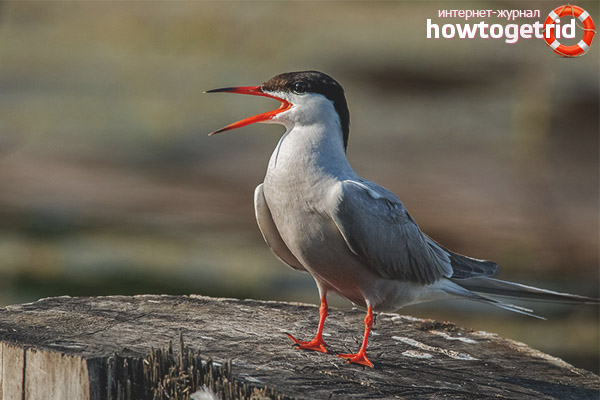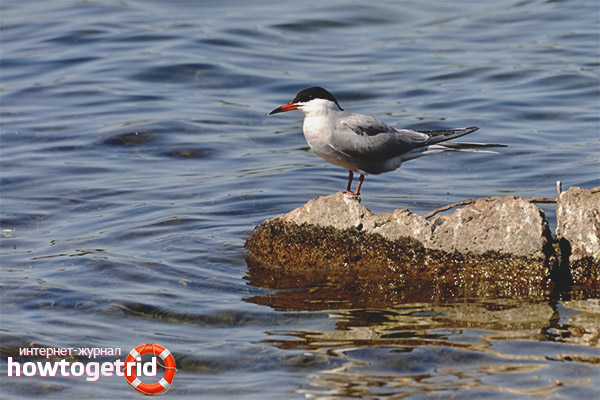The content of the article
Being in nature in the immediate vicinity of rivers or freshwater lakes, many people had to meet medium-sized and completely unremarkable birds with long, refined wings. Many believe that gulls have a characteristic similarity with birds. In fact, they belong to the order Charadriiformes. They are distinguished by a peculiar manner of flight and a hoarse voice, which is heard at disturbing moments. This species of birds is widespread, and prefers to arrange its life in large colonies. Despite their abundance, these birds are quite vulnerable, and people, in particular, cause damage to them.
Appearance
Krachka does not have any outstanding characteristics, it is widespread in latitudes located south of the tundra zone. This bird, which has an elegant silhouette, is similar in size to a wild dove. The length of the tern from tail to beak reaches 35 centimeters, but its wingspan is disproportionately large and amounts to about 80 centimeters. The weight of an adult reaches 180 grams.
The plumage of the bird is distinguished by an inconspicuous color, which consists of dirty white or light gray tones. On the head of the bird there is a zone consisting of black plumage, which has a glossy tint and looks like a cap. In bright colors, only the red beak of the bird is painted, turning at the end into black and its bright red legs. When sound signals are heard, the river tern makes jerky sounds in a rather raspy voice.
In appearance, the bird, in fact, is very similar to a small gull, but terns are distinguished by wings that have a narrower and elongated shape. The next difference is the tail of an inconspicuous bird, which consists of two pointed parts, in the manner of a dovetail. And a characteristic distinction issuing tern is a black cap on her head.
Tern habitat overview
It is a migratory bird, with the advent of winter, large colonies of terns fly to the equatorial or southern latitudes of the planet. In winter, the bird can be found in New Guinea or on the African continent, as well as in the Philippines or in the western part of South America. Nests of river terns have been recorded in some areas of the tundra, but unlike the polar cousin, only river valleys attract it. In the remaining sections of the northern expanses it is impossible to meet her.
As an acceptable habitat, the tern selects the braids of water bodies, with a surface made of pebbles or sand. Also suitable for it are lowlands associated with the coast of water bodies, flat sections of the sea coast, valleys of various rivers. To build nests, the bird does not always prefer the flat sections of the coast; it can also arrange its nests in the areas of mountain ranges located at an altitude of up to 5000 meters - such places were found in the Pamirs and also in Tibet.According to ornithologists, the river tern adheres to stagnant water bodies or quiet rivers with a moderate course for their settlements.
Poultry diet

The river tern is an excellent hunter with an enviable skill. The basis of the bird’s menu is, by and large, various mollusks and small fish. Having noticed her prey, in shallow water or on the surface of the water, she makes a virtuoso throw, sometimes going under the water with her head, leaving only wings on the surface. The technique of such throws is perfected to such an extent that the bird very rarely misses.
The favorite places of hunting for the master of flight are shallows or spits made of sand washed with water, which can be found in abundance in the coastal areas of large rivers. The ideal hunting ground for these predators is located in shallow water, which always attracts fry, which are the main target of terns. The bird makes a smooth flyby around the hunting ground, sometimes hovering in one place, as a rule, before the next throw. In case of an unsuccessful attack, the attempt has to be repeated first.
In addition to river inhabitants, her diet includes a variety of insects, which she can pick up on the fly, using the same techniques in her hunt as the swallow, and from the ground. In choosing insects, terns are completely illegible, and exterminating numerous pests, brings great benefit.
During the breeding of chicks, birds are able to patrol vast territories, looking for prey. According to experts, flight distances can reach 26 kilometers. There is an opinion that, living in large colonies, these birds can cause significant harm to all kinds of fish farms, destroying fry. But the threat here is clearly exaggerated, because terns do not hunt in packs, and the object of their hunt is fish of non-commercial species.
Features of the behavior of terns during the period of hatching
Puberty occurs in river terns when they reach 3-4 years of age. Birds are distinguished by monogamous features of building relationships and are able to keep in touch for several seasons.
Tern males are distinguished by a very active manner of behavior during the mating season. The dance of the temperamental gentleman consists of an aggressive demonstration of his attractiveness. He takes a curved pose, lowers the beak down to a vertical position, and the tail pulls up. Having taken such a pose, makes circular movements, making, at the same time, breathtaking sounds.
To build its nests, the river tern prefers to occupy sites on the shallows of reservoirs with a sand coating or consisting of pebbles. On nests, they are arranged in large colonies, quite often in the neighborhood of other birds. They are forced to take such a position, first of all, fearing an invasion by predators, because such birds alone are not able to withstand even an unrepresentative enemy. But, being in a large colony, together they can give collective rebuff to predators, which are quite large in size, delivering successively numerous blows with their beak and stunning with a frantic roar, consisting of many voices.
In the nesting places of beach lovers, vegetation is practically absent, and birds arrange their nests directly on the surface of the soil. The nest takes the form of a small depression in the soil, which is subsequently lined with litter, consisting of dried grass and feathers. The nest in its cross section near the river tern does not exceed 10 centimeters.
The process of breeding the offspring of a river inhabitant
In the nest of river terns, on average, there are 3 eggs, in rare cases there may be 4. In the masonry color, green shades predominate, it can be a color similar to ocher or olives, covered with dark brown spots. The eggs are quite small in size, up to 5 centimeters long and about 3 centimeters wide.
The female tern female begins the continuous process of incubation of masonry from the moment the first egg appears; the incubation period of the bird does not exceed 22 days. Both partners are busy hatching eggs, the female is most often on the clutch at night, and during the day the male replaces her. The first chicks appear in early July, and in early August they already have the ability to carry out full-fledged flights. This period begins approximately 25 days after the birth of the chicks. The process of hatching offspring does not take a lot of time from the tern.
Video: Tern (Sterna hirundo)











Submit